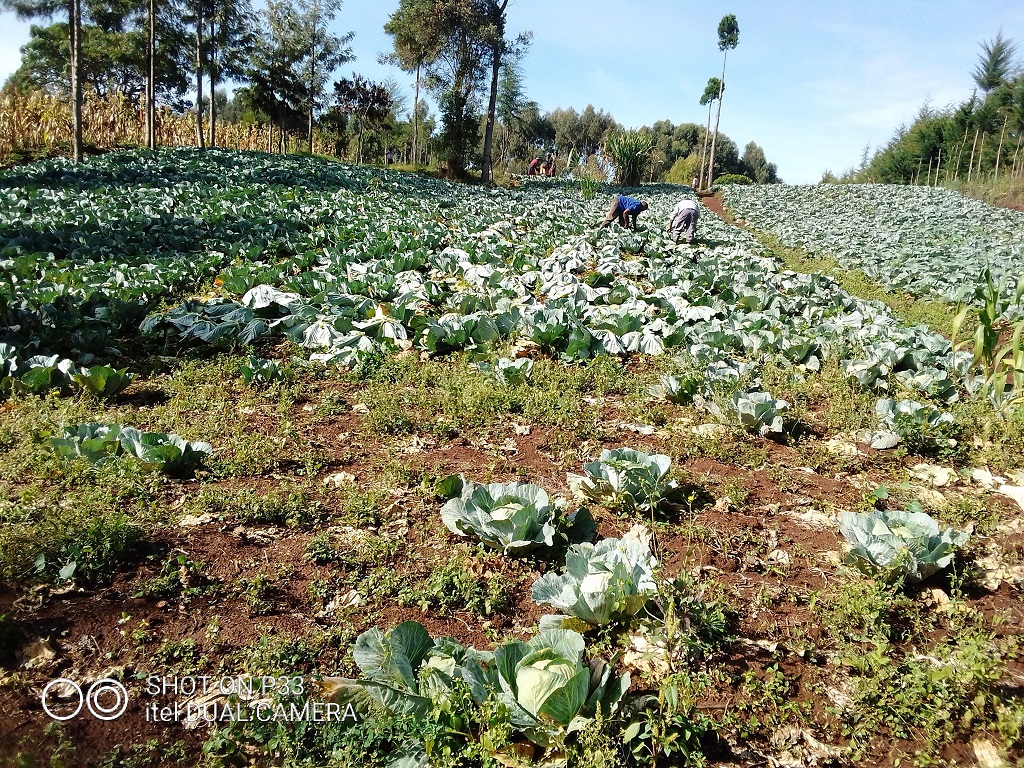
By George Munene
Through strategic long-term investments and farming experience, Timothy Mburu, a farmer at Naro Moru, Nyeri County, keeps his cabbage production cost at just Sh2 per head ensuring he still makes a profit regardless of the prevailing buying market price.
“Most farmers follow a similar guidebook on production, this inflates their production costs, when they could be doing more with less,” says Mburu, who has just harvested 30,000 cabbage on his two-acre farm, selling each at Sh10-12 per head.
For cabbages, as with most other crops, he factors in the following points to reduce his cost of production:
- Nursery management
Cost trimming begins at the nursery stage where Mburu says he achieves up to 99% seed maturity. For an acre, you will need 100 grams of seeds— that’s two 50 gram sachets which cost Sh2500-3000 each. The gloria f1 cabbage is his preferred variety—in his experience, it has the advantages of being a market favourite as well as being hardy, disease-resistant and prolific. Proper nursery bed spacing—often a footnote for farmers, is crucial to ensure high germination rates. Overcrowding crashes the still sensitive developing seedlings as they compete for limited resources in minerals and sunlight. In beds slightly smaller than one meter in width, he sows his seeds in rows three to four inches apart, one row holding 30-40 seeds. He also cautions farmers against overfeeding seedlings whilst they are still in the nursery bed—this he says causes problems once they are transplanted to the field as they become weak. Manuring should be applied judiciously—only mixed in with soil to cover sowed seeds. To obtain plants of good quality in the open field fertilisation in the nursery is important—you will need to apply about one kilogram in fertiliser for seedlings transplanted for an acre
- Field management
Mburu practices zero tillage, only slashing the land he uses to grow his cabbages, this greatly reduces field preparation costs. “Cabbages are a dominant crop that outcompetes most weeds for available resources, you’ll only have to manually hand weed those that grow early at the top dressing phase,” he explains.
Related News: Second-hand tractors open lower cost route for Kenyan farmers to mechanize
Related News: Sunken beds reduce frost losses, irrigation costs
Transplanting should be done wholesale or in blocks to have even growth in the shamba—this prevents having stunted growth as the cabbages transplanted late are unable to compete with those transplanted early.He also leaves a handful of cabbages in his nursery bed to immediately replace those that die whilst being transplanted or whither in the field after transplanting.
- Pest and diseases control
Pesticide application for Mburu is on a reactive basis. He scouts his farm weekly but has no set application routine, only applying pesticides on a need-to basis. “Cabbages are a hardy vegetable, the few pests that a farmer has to be on the lookout for are cutworms, aphids, thrips and the diamondback moth,” he says.
- Manure, fertiliser/foliar application
A lorry of manure costs Sh 30-20,0000, a cost Timothy, whose also a dairy farmer, avoids entirely. He applies a handful of manure for every hole.
For fertilisers, he top-dresses with heavy compound fertilisers such as DAP/ NPK/ Baraka two to three weeks after transplanting and shallow fertilisers like CAN or Urea during head formation. He also applies foliar at the starter, vegetative and head formation stage. Three bags of fertiliser costing Sh3000 cater to an acre while foliar-applied on an acre costs Sh2000.
Related News: Mum cuts food costs 80 % within two months by farming in Jerri cans
- Water source
In 2012, Mburu made a Sh1.2M investment in a ½ acre reservoir capable of harvesting up to 50M litres of water. Water scarcity is no longer an issue he has to contend with. The rainwater he harvests keeps him supplied with water on his farm throughout the year. He uses gravity irrigation to water his farm avoiding any extra costs incurred in the buying of a water pump.
- Management
For an acre’s preparation, Timothy hires three casual hands for four days at a cost of Sh300 every half day. Despite this, Mburu warns, “Casual or telephone farming has left many farmers disenchanted with farming; you have to actively involve yourself in everyday activities on your farm.”
“If possible, farmers should also look to leverage on economies of scale; the monetary and labour cost in producing 2,000 or 10,000 pieces of cabbage is almost the same,” Mburu explains.
















Comments powered by CComment